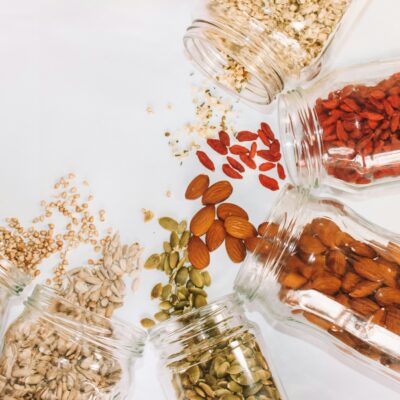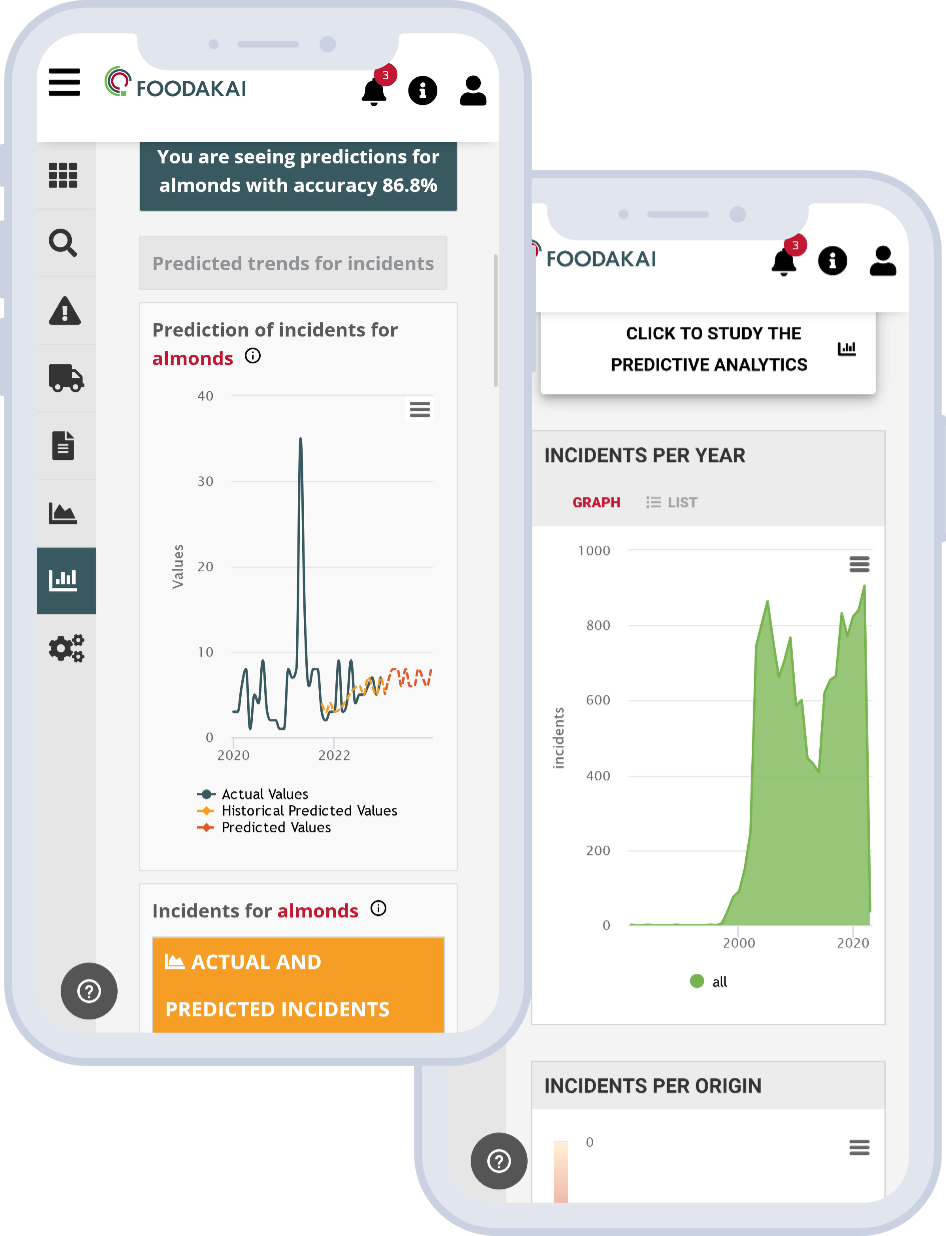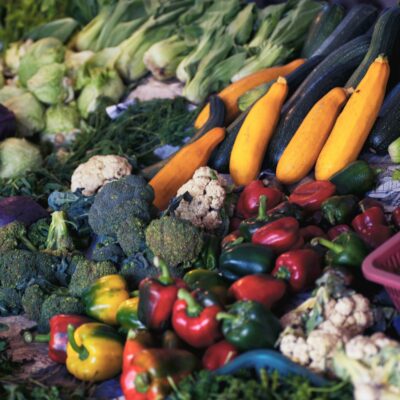
Monthly Forecasts Review: January
Welcome to our inaugural Monthly Forecasts Review! In this series we will be examining the performance of the forecast’s trends for the number of incidents in 10 key food categories for the past month. Additionally, we will examine the forecasts for the top 5 hazard categories (Biological, Chemical, Foreign Bodies, Allergens & Fraud) and dive deeper into the Biological hazards forecasts.
The methodology we follow in order to perform the examination of the performance of the forecast is to compare the forecasted incidents trend for each food product category, and biological hazard, as extracted by FOODAKAI, against the actual recorded number of incidents for these.
Where do we extract the forecasts from?
The forecasts are extracted through FOODAKAΙ, the AI-powered & predictive data analytics platform that collects, harmonizes and correlates data from approximately 200 public authority sources, which are then curated from food safety experts. Through continuously trained and updated AI models and algorithms, FOODAKAI produces high accuracy incidents forecasts trends for all known ingredients, raw materials and hazards, which can be utilized to inform the risk mitigation strategies of food & beverage companies worldwide.
Key Food Categories Forecasts Review
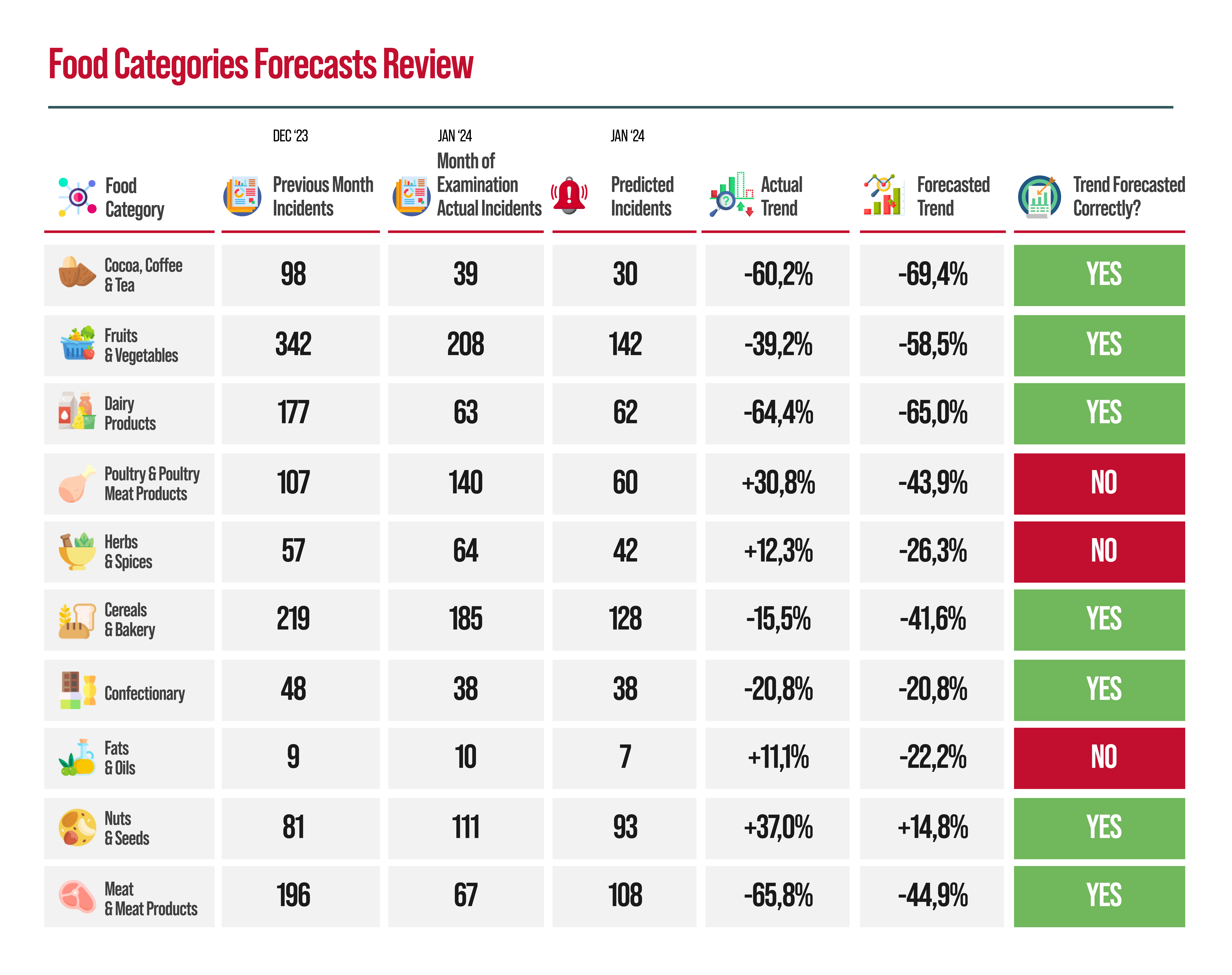
First, let’s examine the overall incidents trend forecasts in 10 Key Food Categories for January.
As indicated above the FOODAKAI platform correctly forecasted the incidents trend for 7 out of the 10 food categories, namely Cocoa, Coffee & Tea, Fruits & Vegetables, Dairy Products, Cereals & Bakery, Confectionary, Nuts & Seeds and Meat & Meat Products. In the Poultry & Poultry Meat Products, Herbs & Spices and Fats & Oils food categories the platform didn’t forecast the trends correctly.
Highlights:
- in the Diary products category, the platform forecasted with great accuracy that the number of incidents would be massively reduced by more than 60% in a single month. More specially FOODAKAI predicted 62 incidents compared to the 63 incidents that were recorded, a 0.56 points difference from forecasts to reality.
- In the Confectionary products category, the platform 100% successfully forecasted the number of incidents and the trend.
- In the Poultry & Poultry Meat Products category, FOODAKAI didn’t successfully forecast the increasing trend of incidents, but forecasted a decrease. This is due to the platform not anticipating the continued peak of incidents December and during January mainly due to Listeria Monocytogenes incidents in turkey in France.
- For the Fats & Oils products category, the platform didn’t forecast an increasing trend but a decreasing trend. However, it should be noted that for product categories such as this that are consisted of low number of incidents and where there is limited testing and inspections performed by public authorities (as indicated also by the single digit incidents reported), there is high chance for volatility in the performance of the forecasting algorithms.
Hazard & Risk Categories Forecasts Review
In this section we examine the performance of forecasts regarding the forecasted incidents trend according to hazard and risk type.
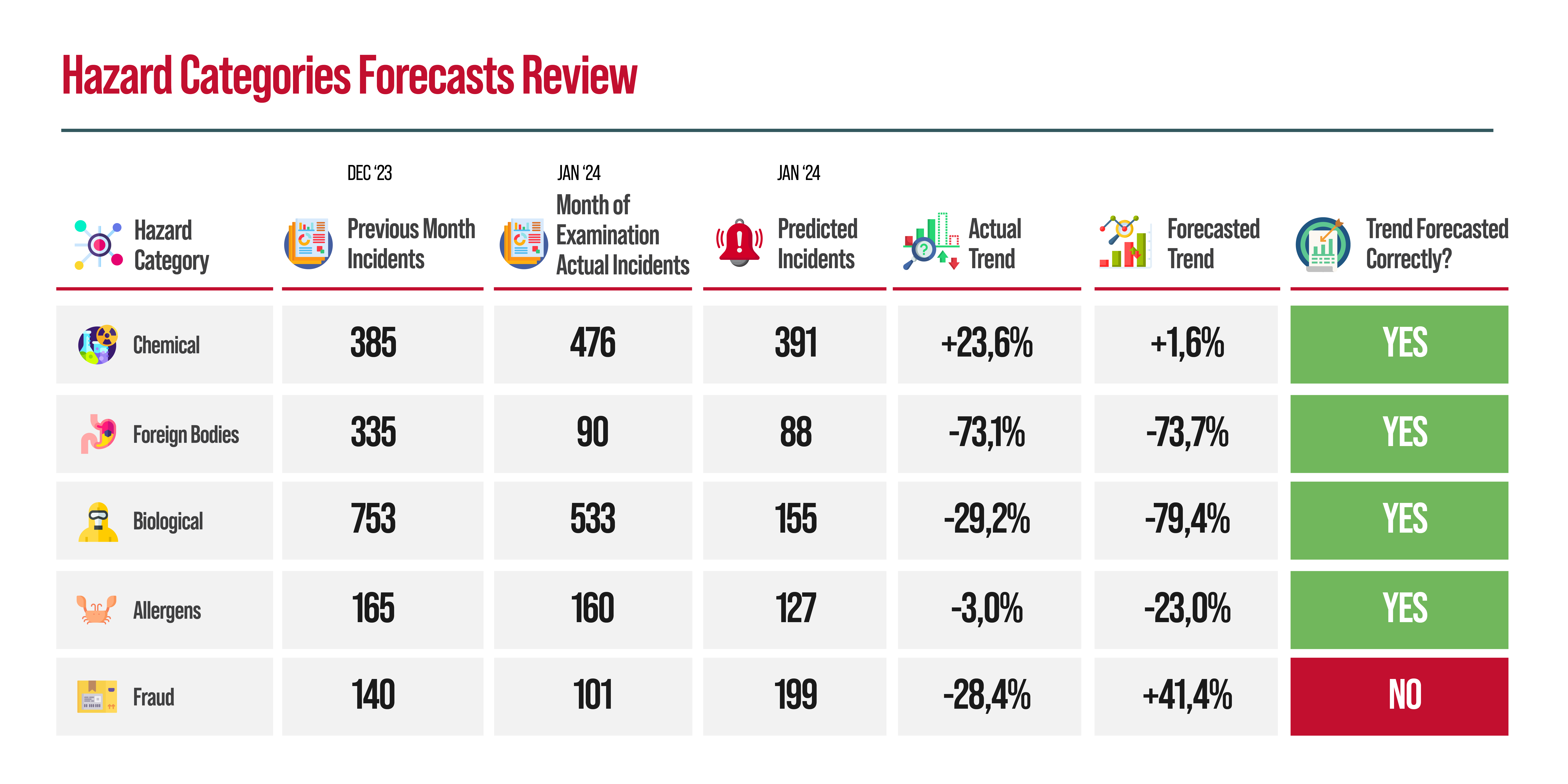
In 4 out of the 5 hazard and risk categories, FOODAKAI successfully forecasted the incidents trend: Chemical, Foreign Bodies, Biological and Allergens. It didn’t forecast the trend for Food Fraud incidents.
Highlights:
- Regarding incidents attributed to Foreign Body Hazards, the platform forecasted a massive decrease in the number of incidents (73,7% decrease) with nearly perfect accuracy. There were 88 incidents predicted versus the 90 recorded incidents, amounting to a difference of only 0.6 points in trend forecasting.
- For incidents attributed to Chemical Hazards, FOODAKAI correctly forecasted an increasing trend for January. However, it didn’t forecast the level of the increase with a difference of (22,08%).
- For incidents attributed to Biological Hazards, FOODAKAI correctly forecasted a decreasing trend for January. However, it didn’t forecast the level of the decrease, anticipating a larger increase.
- In Allergen incidents, the platform successfully predicted the decrease, but anticipated a larger decrease (23%) than the actual (3%).
- For Food Fraud incidents, the platform failed to forecast decreasing trend and anticipated an increase. This was due to the algorithm not fitting well yet with the existing historical data.
Biological Hazards Forecasts Per Food Category
In the following section, we take a look at the forecast trends for incidents attributed to biological hazards per food product category.
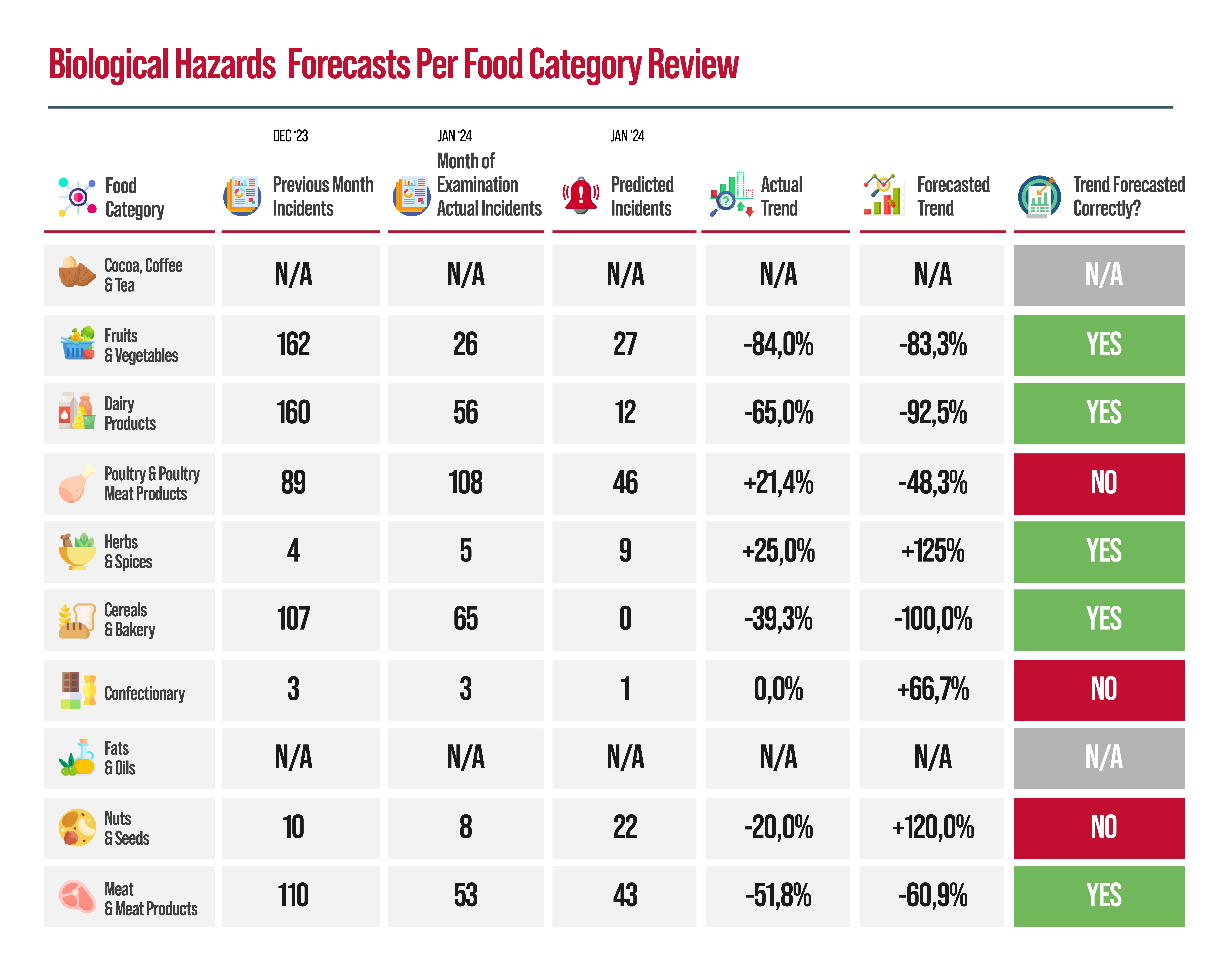
The platform forecasted correctly the biological hazard incidents in 5 food categories, Fruits & Vegetables, Dairy Products, Herbs & Spices, Cereals & Bakery and Meat & Meat Products. For the Poultry & Poultry Meat Products, Confectionary, Nuts & Seeds it didn’t correctly forecast the incidents trend. For the Cocoa, Coffee & Tea and Fats & Oils Category no incidents were recorded.
Highlights:
- Regarding Biological Hazards in Fruits & Vegetables, the platform forecasted the near exact trend (difference of 0.7 points) and number of incidents (difference of 1). It is notable that the platform forecasted a large decrease of more than 80% with great accuracy.
- For Biological incidents in Dairy Products as well as Cereal & Baker Products, while FOODAKAI forecasted the decreasing trend successfully it didn’t predict the level of decrease. In both cases it forecasted a larger decrease than the actual.
- For Herbs & Spices Biological Incidents the platform correctly anticipated an increase in the number of incidents but a much higher increase than what was recorded (125% instead of 25%)
- In both Poultry Meat & Poultry Meat Products and Nuts & Seeds food product categories the platform failed to forecast correctly the trends due to the algorithm not fitting well yet to the existing historical data.
As the food industry is continuously facing new risks, whether it is from unforeseen disruptions in the supply chain, geopolitical issues or the effects global climate change, it’s becoming increasingly necessary that food companies are able to anticipate future risk. Through highly accurate forecasts on future risks to their supply chain, food companies can drastically enhance their preemptive measures and avoid future food safety incidents.
Want to learn more about how you can benefit from such forecasts?
Schedule a call here.
Want to receive helpful food safety intelligence in your inbox?


